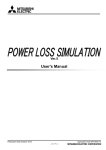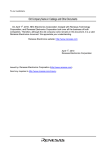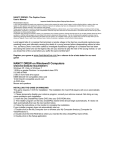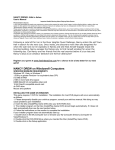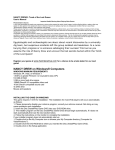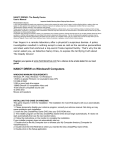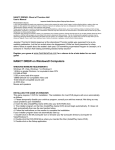Download User Manual
Transcript
POWER LOSS SIMULATION SOFTWARE User Manual ( 1 / 13 ) 1. Main changes with Mitsubishi power module loss simulation Ver.4.03 The power loss simulation software “Melcosim Ver.4.03” for Mitsubishi power modules has been revised. Details of the revision are shown below. (1) “Melcosim Ver.4.03” shows SW(on) and SW(off) of IGBT. Ver4 Ver4.03 (2) The Japanese data sheet or English data sheet can be seen by selecting the button. ( 2 / 13 ) 2. Setup and Execution (1)Download The power loss simulation software can be download free from the following Mitsubishi Electric web site. <http://www.mitsubishichips.com/Global/index.html> Click the Submit button after the information table is filled out. Then, enter the download page. *Personal information is strictly managed and only used for software version update notification. The downloaded software is compressed in ZIP format; it can be uncompressed with various file decompression tools. There are 9 files included in the compressed ZIP file. Melcosim.exe, Function.dll, Simcore.dll, ReadMe.txt LimitInfo.dll, MFC71.dll, msvcp71.dll, msvcr71.dll, PassInfo.dll, Please copy or move the uncompressed files to a local directory in your PC. The software may not work from a network hard disk. (2)Execution Click the “ Melcosim.exe” icon to start-up the simulation software. PC type CPU DOS/V PC PentiumⅢ 500M H z or above Memory 64MB or above HD 20MB or more of free space OS Windows2000, Windows XP, Windows VISTA There is a validation date included in the software in order to ensure that the latest simulation data is used. The software might not work properly if the IE of your OS is not updated. Use IE6 SP1 to update Windows2000 High Encryption Pack to update windows2000. *) Pentium is a registered trademark of Intel Corporation in the U.S. and/or other countries. *) Windows is a registered trademark of Microsoft Corporation in the U.S. and/or other countries. ( 3 / 13 ) 3. Operation Guidance When the software starts up, a message window pops-up showing the number of remaining days for which the software is valid. Click OK. The software has expired if the date is overdue. (1)Tool Bar Tool bar Menu bar File →New Module Graph → Condition Calculate File →Export Edit →Copy File →Print Help Description Open a new window A new condition window will open. Parallel simulation becomes possible. Select the active condition window from the menu bar windows. Select the target module. Module types and data are subject to update without pre-notification. Please make confirmation on our homepage. (Module selection window will appear even if the “Not Selected” button is clicked at the target device area of the initial condition window. Move to the condition window. Start calculation. Save calculated result (in txt, csv format). Conditions and graphs are saved in txt file and csv file respectively. Therefore it is possible to edit the data with, e.g. Excel. Copy the condition window. The data and calculation results window is hard copied and can be pasted to a document such as a word file. Print Print the condition window, or a graph. Help ( 4 / 13 ) (2) Condition Window Power loss conditions and results are displayed in the condition window. ① Target Device ② Device Data Profile ③ Modulation ④ Io (condition) ⑤ Calculation Results ① Shows the target device name Shows the thermal resistance of the target device. The Rth(j-c) specification is the value per one IGBT switch, not per one module. Only the IGBT switches in the inverter circuit are counted, therefore the number given is “6” even for a 7 in 1 (with brake part) module. Modulation strategy selection. 3-phase PWM modulation for 3-Arm VVVF inverter; 2-phase PWM modulation for 2-Arm VVVF inverter; Special operation such as chopper control or DC brake is also possible. Inverter operating condition input. Click “ ” on the tool bar to begin the calculation ② ⑤ ③ ④ Vcc M Rg Iout PWM pulse Vout 1/fc Io ON OFF ton toff duty =ton / (ton+toff) Tf :heatsink temperature φ P.F =cosφ Note: Rg input is not available for IPM, and duty input is only available for chopper calculation. ( 5 / 13 ) (3) Range of input data The range may be different for different modules. The following table shows a typical instance of a standard module. An input beyond the defined range will generate an alarm message; Io Output current however, the calculation will still be carried out. The current value can be selected to input either in peak value or rms value. The peak value means the peak value of a sinusoidal current or the peak value of a DC current. Ripple component is not included. An input exceeding the recommended VCC of the module will VCC DC-link voltage generate an alarm message; however, the calculation will still be carried out. VCC≦400V for 600V modules, VCC≦800V for 1200V modules, VCC≦1100V for 1700V modules (Note: some modules may have a different range setting) fc Carrier frequency An input exceeding 20kHz will generate an alarm message, however, the calculation will still be carried out. (Note: some modules may have a different range setting) fo Output frequency Input is only available for modulation of 3-Arm and 2-Arm. An input under 0.1Hz will generate an alarm message (Note: some modules may have a different range setting) Rg(on),Rg(off) Gate resistance Input is only available for IGBT modules. An input beyond the defined range will generate an alarm message; however, the calculation will still be carried out. The input range is -1≦PF≦1. PF Power factor An input beyond the setting range will generate an alarm message. The input range is 0∼1 for 3-arm 3-phase modulation, and 0∼1.154 Modulation Ratio Modulation depth for 2-arm 2-phase modulation. An input beyond the setting range will generate an alarm message. This Input is only available for chopper calculations, with a range of 0 duty Duty ∼1. Duty is a function of Modulation Ratio in chopper operation Duty=Modulation Ratio/2+0.5 An input beyond the setting range will generate an alarm message. Input range is the safe operation temperature range or junction Tf Heat-sink temperature range of the module. temperature An input beyond the setting range will generate an alarm message. Keep conditions Keep calculation Keeps calculation conditions (except Rg) when module is conditions changed. Check box in order to keep calculation conditions. Alarm message window: An alarm message also appears when the calculated junction temperature exceeds the specification under acceptable input conditions. In addition, if the VCC input exceeds the module blocking voltage, the calculation will still be carried out; however, the voltage cannot be applied in actual operation. ( 6 / 13 ) 4. Simulation Essentials (1) Power Loss Calculation Method The new version of loss simulation software is capable of 3-phase sinusoidal PWM modulation, 2-phase PWM modulation and chopper (including DC brake) operation simulations. The simulations are based on the formulas below. A) Sinusoidal PWM for VVVF inverter Calculate the module power loss for inverter VVVF operation. The output current is sinusoidal. Although the formula for different modulation schemes is different, they can be approximated by the same basic formula as below. ■Assumptions ①PWM controlled VVVF inverter with sinusoidal output current. ②PWM signal is generated by comparing sinusoidal and triangular waveforms. ③The PWM signal duty varies within 1 D 1 D ~ (% / 100) , where D is the modulation depth. 2 2 ④No ripple component is included in the output current. ⑤Inverter power factor is cosθand the load is purely inductive. ■Formula PWM signal duty is a function of phase angle x as 1 D sin x , which is equivalent to the output 2 voltage variation. From the power factor, cosθ, the output current and its corresponding PWM duty at any phase angle can be obtained as below: Output current Icp sin x 1 D sin( x PWM Duty 2 ) ※2-phase modulation is different here. On the other hand, the IGBT collector-emitter saturation voltage VCE(sat) and FWD forward voltage drop VEC at that time are calculated by Vce ( sat ) Vec Vce( sat )(@ Icp sin x) ( 1) Vec (@ Iecp( Icp) sin x) Therefore, the static power loss of one IGBT chip is obtained by 1 2 0 ( Icp sin x) Vce( sat )(@ Icp sin x) 1 D sin( x 2 ) dx Also similarly, the FWD power loss is obtained by 1 2 2 (( 1) Icp sin x)(( 1) Vec(@ Icp sin x) 1 D sin( x 2 ) dx The IGBT switching loss does not depend on PWM duty; it is calculated by the following formula. 1 2 0 ( Psw(on)(@ Icp sin x) Psw(off )(@ Icp sin x)) fc dx The FWD switching loss is calculated by 1 2 0 ( Err (@ Icp sin x)) fc dx Note: ・VCE(sat) and VEC are for Tj=125℃. ・Psw(on), Psw(off) and Err are for half bridge switching at Tj=125℃. B) 2-phase PWM modulation In 2-phase modulation drive mode, simulation for modulation depth over 1, but below 1.154, becomes possible. Comparing to general 3-phase modulation, the voltage conversion ratio is higher, and the power ( 7 / 13 ) loss is lower due to the non-switching period, such as ON-hold or OFF-hold, occurring in 60 degrees of the cycle. The calculation method is the same as that for 3-phase modulation. C) Chopper Operation In DC chopper or brake mode, an IGBT in a certain phase will do continuous switching while other phase IGBTs are kept ON or OFF. The output current is supposed to be a DC current. M Iout ON OFF ON OFF The power loss for chopper operation is calculated with the formulas shown below. No ripple component is included. The average power loss of the IGBT and FWD at current Io are: PDC Io Vce ( sat )(@ Io) Duty PSW Psw(@ Io) fc P ( IGBT ) PDC PSW for the IGBT, and PDC Io Vec (@ Io) (1 Duty) PSW Err (@ Io) fc P ( Diode) PDC PSW for the FWD. ( 8 / 13 ) ■ The following items need to be considered when making power loss and thermal calculations: ①Use the power loss value for the worst case working condition. ②When Tj_Max is over 125°C, the temperature ripple calculation may be underestimated because all device data is for Tj=125°C. Also, consider that there is additional margin under conditions that are Tj_Ave≤125°C and Tj_max≤125°C. In case of Tj_Ave>125°C or Tj_max>125°C, consider adding margin since the temperatures may be underestimated. Tj(IGBT)_Max Tj(IGBT)_Ave Tj(Diode)_Max Tj(Diode)_Ave ■ Limitations of Ver.4.03 power loss simulation software: ① The performance data used for simulations is obtained by linear approximation from several points of measured data. Therefore, calculation errors occur for Vce(sat) at low current, switching loss near 0A, etc. The calculation results are overestimated under these conditions, please consider it as margin. In addition, if the input parameters are outside of the specified range, the error produced from the linear approximation will become large, and an exact calculation result cannot be obtained. Therefore, please input each parameter within its acceptable range. If the parameter input is outside of the acceptable range an alarm message will be displayed; however, the calculation will still continue and the results will be shown. ② Temperature ripple calculation is possible with Ver.4.03, but calculation errors can occur, especially with a small sample rate. This calculation is possible only under the following conditions: 1)Modulation is 3-Arm or 2-Arm, and fo is under 30Hz 2)Modulation is Chopper ( 9 / 13 ) (2) Temperature Rise Calculation Example: PS21765 in 3-phase PWM operation Thermal resistance per one switch (Some devices indicate this value as per one module in their spec.) Total IGBT power loss of one module P(IGBT)(W/IGBT)×chip number Total FWD power loss of one module P(Diode)(W/Diode)×chip number Total power loss of a module P(IGBT)(W/Module)+P(Diode)(W/Module) Note) The power loss per one module is not calculated in chopper operation. The temperature rise is calculated based on the following thermal flow chart. Tj P(IGBT) P(IGBT)+P(Diode) IGBT Rth(j-c):IGBT 1 arm P(Diode) Tc Rth(c-f) FWD Rth(j-c):Diode × chip number Ta Tf Rth(f-a) ※ Tf is the Heat-sink temperature Temperature rise between junction (IGBT&FWD) and case is calculated to be Delta-Tj-c(IGBT): P(IGBT)*Rth(j-c):IGBT = 4.96(W)*1.3(k/W) = 6.45°C Delta-Tj-c(Diode): P(Diode)*Rth(j-c):Diode = 0.80(W)*3.0(k/W) = 2.39°C Case temperature is calculated to be Tc = Tf + P(Total) * Rth(c-f)/(number of switches) = 90°C + 156.04(W/Module) * 0.228(k/W) / 6 = 91.73°C Where P(Total) is the total loss of one module and Rth(c-f) is the contact thermal resistance of one switch. (The heat is supposed to distribute across the full module in inverter operation) Note: for chopper operation calculation, the case temperature is calculated by Tc = Tf + ( P(IGBT) + P(Diode) ) * Rth(c-f) However, there is only one IGBT or one FWD working per one arm in chopper operation, therefore, the calculated value is larger than the actual temperature rise. IGBT/FWD junction temperature Tj is obtained by Tj(IGBT) = Tc + Delta-Tj-c(IGBT) = 91.73°C + 6.45°C = 98.17°C Tj(Diode) = Tc + Delta-Tj-c(Diode) = 91.73°C + 2.39°C = 94.12°C Note: Precaution of MOS module and RC-IGBT_MOD calculation The diodes of MOSFETs and RC-IGBTs are body diodes. Power loss and temperature rise for MOSFET and RC-IGBT are calculated by following equations. MOS_MOD:Delta-T(j-c)=Rth(j-c)*( P(MOS) + P(Diode)) (MOSFET) RC-IGBT_MOD:Delta-T(j-c)= Rth(j-c)*( P(IGBT) + P(Diode)) (RC-IGBT) ( 10 / 13 ) 5. Graph Display Function The simulated results can be confirmed simply by using the graphing function. Select the “graph” menu in the menu bar to display a graph. Select X axis Select Y1 axis Select Y2 axis Combination table X axis Output Current, Icp(A) Switching Frequency(kHz) Time(s) Y1 axis Tj(IGBT)_Ave & Tj(Diode)_Ave Tj(IGBT)_Max & Tj(Diode)_Max Power(IGBT & Diode) Delta_Tj(IGBT)_Ave & Delta_Tj(Diode)_Ave Delta_Tj(IGBT)_Max & Delta_Tj(Diode)_Max Tj(IGBT)_Ave & Tj(Diode)_Ave Tj(IGBT)_Max & Tj(Diode)_Max Power(IGBT & Diode) Max Current(IGBT & Diode) Delta_Tj(IGBT)_Ave & Delta_Tj(Diode)_Ave Delta_Tj(IGBT)_Max & Delta_Tj(Diode)_Max Tj(IGBT)_Ave & Tj(Diode)_Ave Tj(IGBT) & Tj(Diode) Delta_Tj(IGBT)_Ave & Delta_Tj(Diode)_Ave Delta_Tj(IGBT) & Delta_Tj(Diode) Y2 axis Tj(IGBT)_Ave & Tj(Diode)_Ave Tj(IGBT)_Max & Tj(Diode)_Max Power(IGBT & Diode) Delta_Tj(IGBT)_Ave & Delta_Tj(Diode)_Ave Delta_Tj(IGBT)_Max & Delta_Tj(Diode)_Max Tj(IGBT)_Ave & Tj(Diode)_Ave Tj(IGBT)_Max & Tj(Diode)_Max Power(IGBT & Diode) Max Current(IGBT & Diode) Delta_Tj(IGBT)_Ave & Delta_Tj(Diode)_Ave Delta_Tj(IGBT)_Max & Delta_Tj(Diode)_Max Tj(IGBT)_Ave & Tj(Diode)_Ave Tj(IGBT) & Tj(Diode) Delta_Tj(IGBT)_Ave & Delta_Tj(Diode)_Ave Delta_Tj(IGBT) & Delta_Tj(Diode) Note) “Tj(IGBT) & Tj(Diode)” and “Delta_Tj(IGBT) & Delta_Tj(Diode)” are possible under following conditions. 1)Modulation is 3-Arm or 2-Arm, and fo is under 30Hz 2)Modulation is Chopper ( 11 / 13 ) Graph Display A) Temperature vs. Current curve B) Power, Temperature vs. Current curve C) Power vs. Carrier Frequency curve D) Power, Max. Current vs. Carrier Frequency curve E) Temperature vs. Time curve F) Temperature vs. Time curve ( 12 / 13 ) Notice for Safe Designs We are making every effort to improve the quality and reliability of our products. However, there are possibilities that semiconductor products are damaged or malfunction. Please pay attention to take safety into consideration and to adopt redundant, fireproof and malfunction-proof designs, so that the breakdown or malfunction of these products would not cause accidents including human life, fire, and social damages. Notes When Using This Specification This specification is intended as reference materials when customers use Mitsubishi Electric semiconductor products. Thus, we disclaim any warranty for exercise and/or use of our intellectual property rights and other proprietary rights regarding the product information described in this specification. We assume absolutely no liability in the event of any damage or any infringement of third party’s rights arising from the use of product data, diagrams, tables, and application circuit examples described in this specification. All data including product data, diagrams, and tables described in this specification are correct as of the day it was issued, and they are subject to change without notice. Always verify the latest information of these products with Mitsubishi Electric and its agents before purchase, and make confirmation from Mitsubishi Electric web site http://www.mitsubishielectric.co.jp/semiconductors/ as well. The products listed in this specification are not designed to be used with devices or systems, which would directly endanger human life. Should you intend to use these products for special purposes such as transportation equipment, medical instruments, aerospace machinery, nuclear-reactor controllers, fuel controllers, or submarine repeaters, please contact Mitsubishi Electric and its agents. Regarding transmission or reproduction of this specification, prior written approval of Mitsubishi Electric is required. Please contact Mitsubishi Electric and its agents if you have any questions about this specification. Power Device Works, Mitsubishi Electric Drawing : 13. Jan. ‘05 Revision : 02. Mar. ‘09 ( 13 / 13 )













